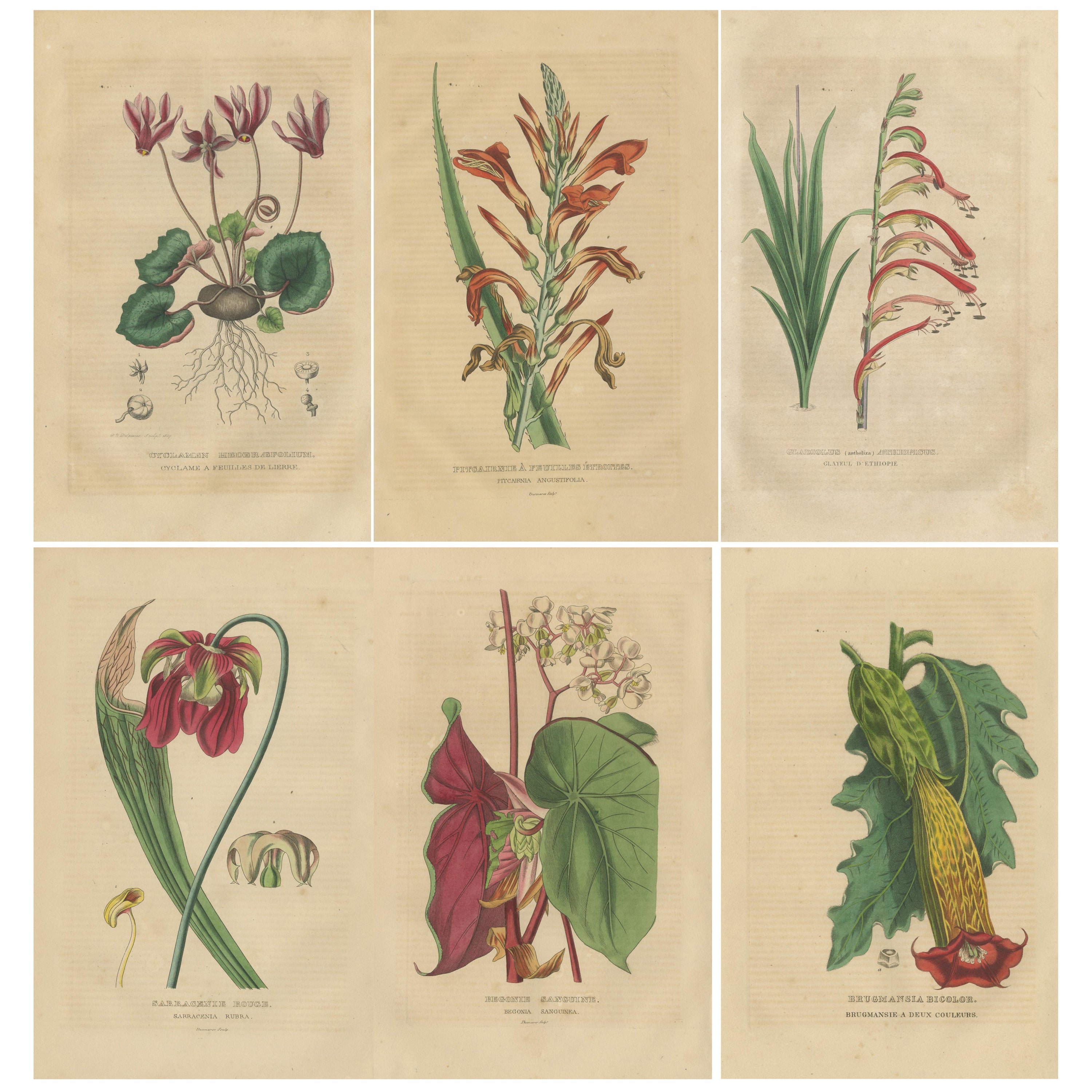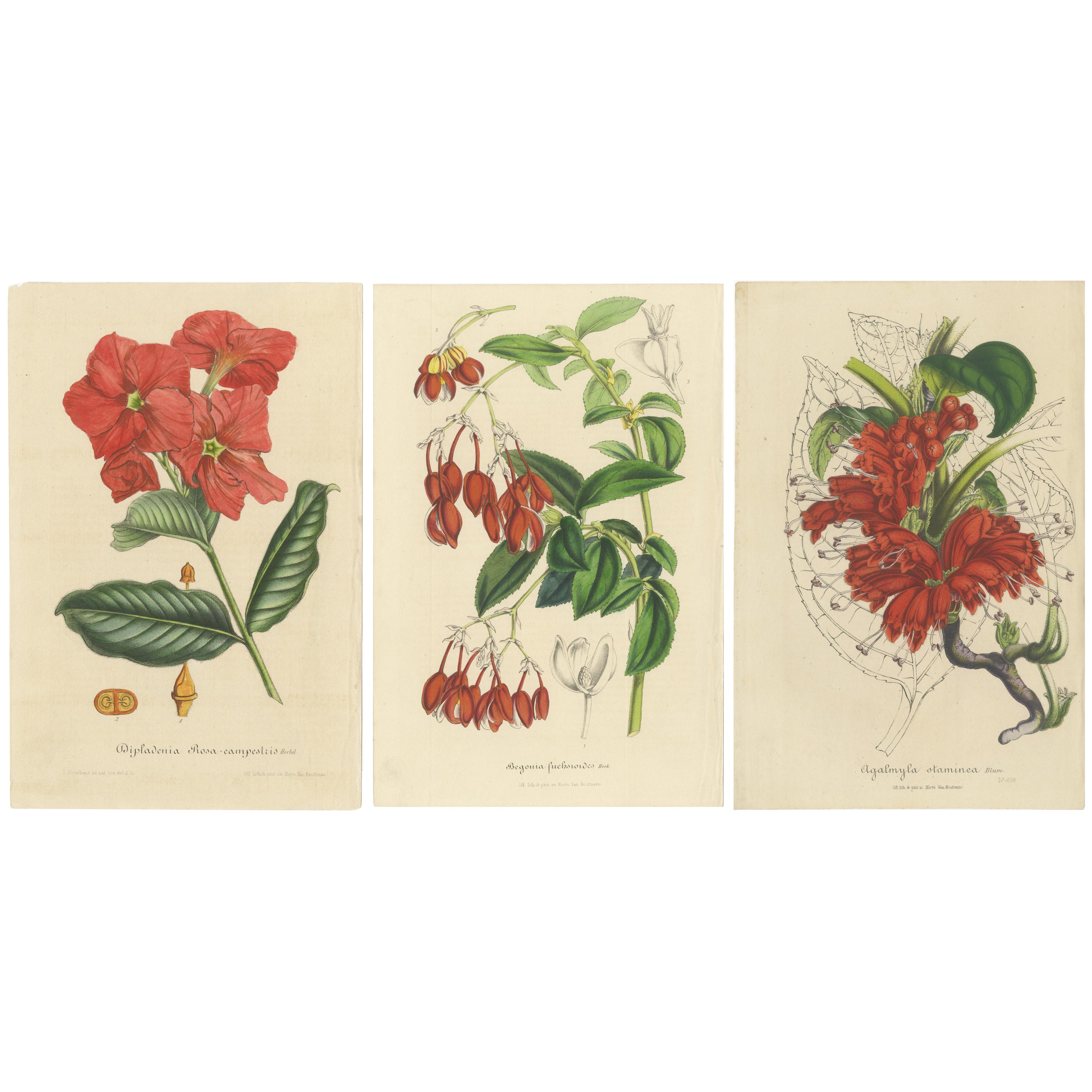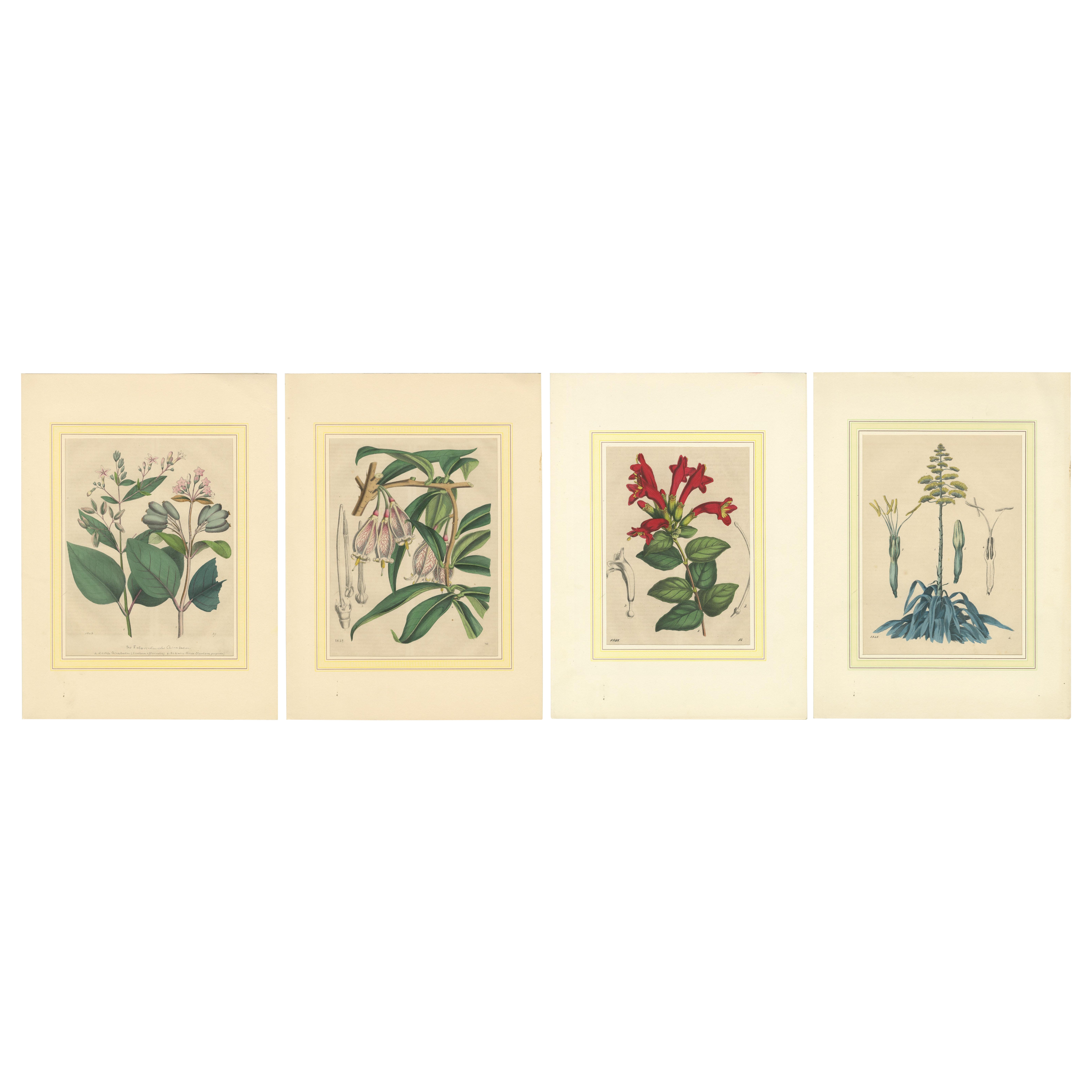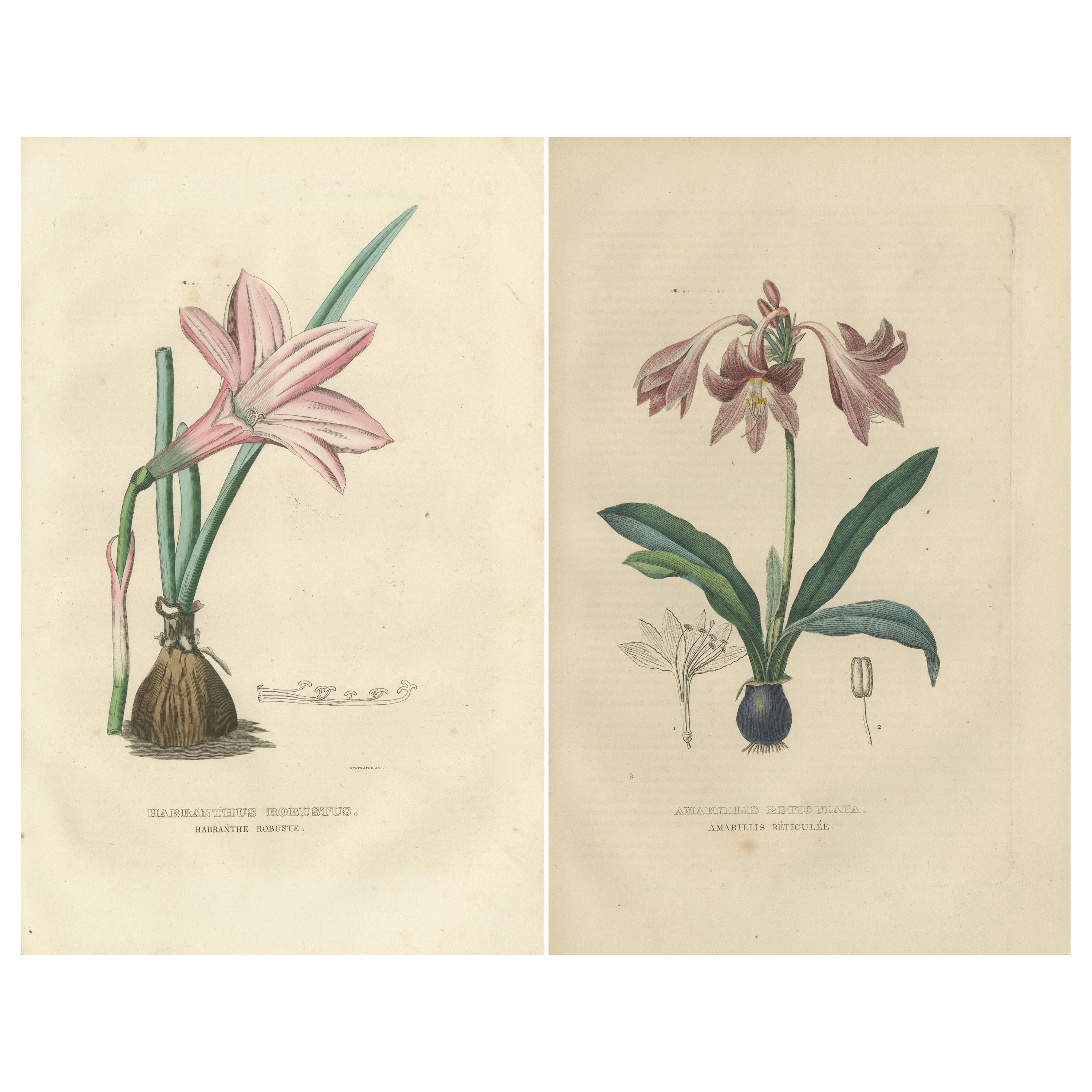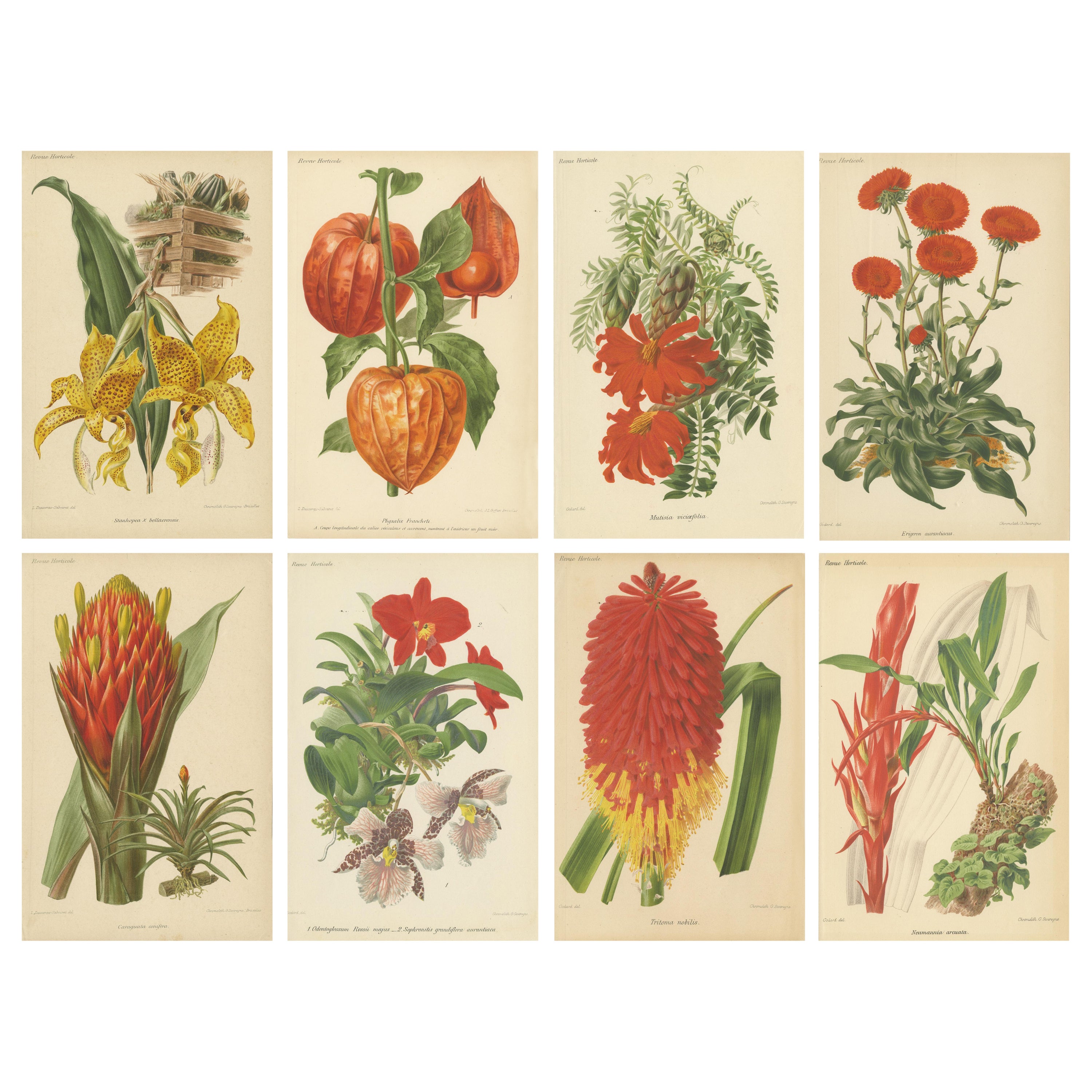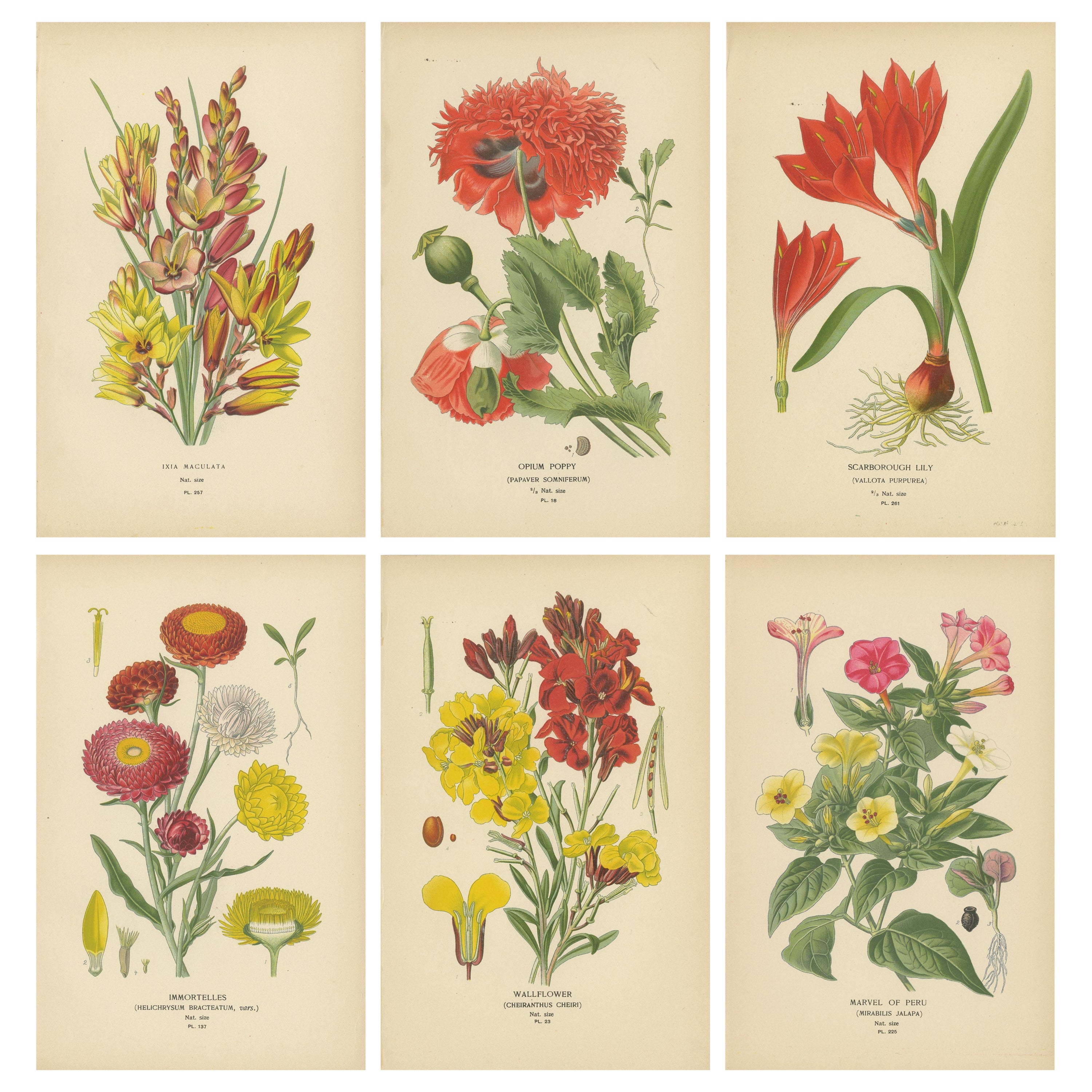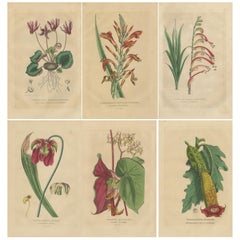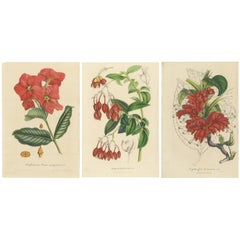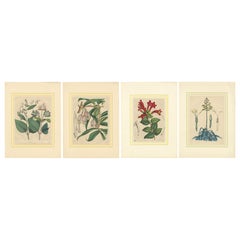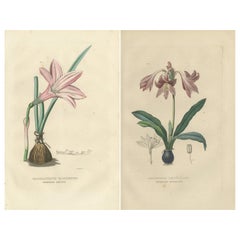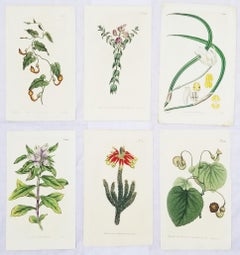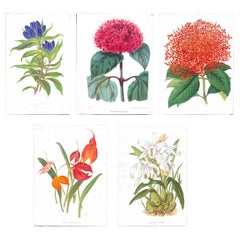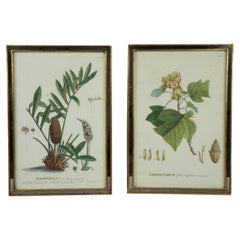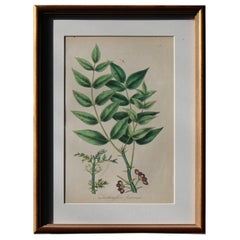Items Similar to Exquisite 1818 Handcoloured Botanical Engraving Collection by Curtis
Want more images or videos?
Request additional images or videos from the seller
1 of 8
Exquisite 1818 Handcoloured Botanical Engraving Collection by Curtis
$553.51per set
$691.89per set20% Off
£409.22per set
£511.52per set20% Off
€464per set
€580per set20% Off
CA$761.35per set
CA$951.68per set20% Off
A$846.28per set
A$1,057.85per set20% Off
CHF 443.60per set
CHF 554.50per set20% Off
MX$10,335.17per set
MX$12,918.96per set20% Off
NOK 5,538.13per set
NOK 6,922.67per set20% Off
SEK 5,210.35per set
SEK 6,512.94per set20% Off
DKK 3,532.42per set
DKK 4,415.53per set20% Off
Quantity
About the Item
The image showcases six hand-colored botanical copperplate engravings on vellin paper from the early 19th century, attributed to Samuel Curtis's publication.
Here's a description of the plants along with their Latin and common English names, reflecting the detail and accuracy typical of botanical artwork from this period:
1. Top Left: This depicts the *Poinsettia pulcherrima*, commonly known as the Poinsettia. Native to Mexico and Central America, it's particularly celebrated for its bright red and green foliage and is widely used in Christmas floral displays.
2. Top Middle: Shown is *Rhododendron indicum*, known as the Azalea. This species is famous for its vibrant blooms and is a popular choice for ornamental horticulture.
3. Top Right: This illustration represents *Rosa chinensis*, commonly referred to as the China Rose. It's significant for its role in the breeding of many modern garden roses, admired for its repeat flowering unlike most wild roses.
4. Bottom Left: The flower depicted is *Anemone coronaria*, known as the Poppy Anemone. It is a species of the genus Anemone, native to the Mediterranean region, noted for its vibrant, showy flowers.
5. Bottom Middle: Illustrated here is *Begonia coccinea*, which carries the common name Angel Wing Begonia. Recognizable by its wing-shaped leaves and clusters of red flowers, it is popular in horticulture.
6. Bottom Right: The image shows *Hydrangea macrophylla*, commonly known as Bigleaf Hydrangea or French Hydrangea. This species is renowned for its large flower heads and is widely cultivated in many parts of the world.
These illustrations are special not only for their scientific accuracy but also for their artistic execution. The meticulous detail and vibrant coloration help convey the unique characteristics of each plant, serving both educational and aesthetic purposes during a time when live specimens were hard to come by in many regions.
This prints originate from ‘Curtis Botanical Magazine.’ William Curtis began publication of the Botanical Magazine in February 1787 and it continued even after his death almost without interruption until 1948. The images were engraved and hand-coloured by many reknown artists. The plates are known for their fine detail and delicate hand coloring. The prints are all copper engravings to Volume 70, then continue with stone or zinc lithography until the introduction of color printing in 1948.
- Dimensions:Height: 9.06 in (23 cm)Width: 5.52 in (14 cm)Depth: 0 in (0.02 mm)
- Sold As:Set of 6
- Materials and Techniques:Paper,Engraved
- Period:
- Date of Manufacture:1818
- Condition:Condition: Very good, given age. General age-related toning and/or occasional minor defects from handling. Please study scan carefully.
- Seller Location:Langweer, NL
- Reference Number:Seller: BG-13761-1, BG-13761-2, BG-13761-3, etc1stDibs: LU3054341415602
About the Seller
5.0
Recognized Seller
These prestigious sellers are industry leaders and represent the highest echelon for item quality and design.
Platinum Seller
Premium sellers with a 4.7+ rating and 24-hour response times
Established in 2009
1stDibs seller since 2017
2,607 sales on 1stDibs
Typical response time: <1 hour
- ShippingRetrieving quote...Shipping from: Langweer, Netherlands
- Return Policy
Authenticity Guarantee
In the unlikely event there’s an issue with an item’s authenticity, contact us within 1 year for a full refund. DetailsMoney-Back Guarantee
If your item is not as described, is damaged in transit, or does not arrive, contact us within 7 days for a full refund. Details24-Hour Cancellation
You have a 24-hour grace period in which to reconsider your purchase, with no questions asked.Vetted Professional Sellers
Our world-class sellers must adhere to strict standards for service and quality, maintaining the integrity of our listings.Price-Match Guarantee
If you find that a seller listed the same item for a lower price elsewhere, we’ll match it.Trusted Global Delivery
Our best-in-class carrier network provides specialized shipping options worldwide, including custom delivery.More From This Seller
View AllBotanical Rarities: Pristine Hand-Colored Engravings from 1845
Located in Langweer, NL
This image is a beautiful collage of antique hand-colored botanical engravings from 1845, each showcasing a different plant species with exceptional detail and vibrant colors. The en...
Category
Antique Mid-19th Century Prints
Materials
Paper
$528 Sale Price / set
24% Off
Free Shipping
Exquisite Botanical Illustrations from Curtis’s Botanical Magazine (1847)
Located in Langweer, NL
These beautiful hand-colored botanical illustrations, drawn and lithographed by the renowned artist Walter Hood Fitch, were featured in Sir William Jackson Hooker's *"Curtis's Botanical Magazine,"* published in London in 1847. Fitch was one of the most prolific and skilled botanical illustrators of the 19th century, known for his ability to capture the intricate details and vibrant hues of the plants he depicted.
Sir William Jackson Hooker, a famous British botanist and the director of the Royal Botanic Gardens, Kew, commissioned these illustrations as part of his work to document newly discovered plants from around the world. The *Curtis’s Botanical Magazine* has been published since 1787 and remains one of the longest-running botanical periodicals.
Detailed Descriptions of Each Plant
#### 1. **Dipladenia Rosa-campestris** (*Hortul. ex Veitch*)
- **English Name**: Rose Dipladenia
- **Description**: This illustration showcases *Dipladenia rosa-campestris*, a striking flowering plant known for its showy pink to deep red trumpet-shaped flowers. Native to tropical regions of South America, particularly Brazil, *Dipladenia* belongs to the family Apocynaceae and is prized in horticulture for its vibrant blooms and ability to climb. Fitch's illustration emphasizes the waxy leaves and the vivid color of the petals, bringing the plant to life on the page.
#### 2. **Begonia fuchsioides** (*Hook.*)
- **English Name**: Fuchsia-flowered Begonia
- **Description**: The *Begonia fuchsioides* is depicted with its characteristic red, pendulous flowers, which closely resemble the blooms of fuchsia plants. This species of Begonia is native to tropical regions and is popular for its delicate, bell-shaped flowers and glossy leaves. Fitch’s attention to the arrangement of the leaves and the contrast between the flowers' vibrant red and the soft green leaves provides a lifelike representation of this exotic plant.
#### 3. **Agalmyla staminea** (*Blume*)
- **English Name**: Staminate Agalmyla
- **Description**: This illustration captures the unique red tubular flowers of *Agalmyla staminea*, a plant native to Southeast Asia. The species is part of the Gesneriaceae family and is known for its bright, showy flowers that grow in dense clusters. Fitch’s careful rendering of the plant’s leaves and the intricate veining, along with the vibrant red flowers, highlights his talent for bringing the botanical subject to life with both scientific accuracy and artistic flair.
### About the Makers
#### **Walter Hood Fitch** (Artist and Lithographer)
Walter Hood Fitch (1817–1892) was one of the most influential botanical artists of the 19th century, working primarily with Sir William Hooker and later his son, Joseph Dalton Hooker, at Kew Gardens. He produced thousands of illustrations for various botanical publications, including *Curtis’s Botanical Magazine*, where he was responsible for the majority of its plates from 1834 to 1877. Fitch’s mastery of lithography allowed him to create richly detailed and accurate depictions of plants, with a particular talent for illustrating both the botanical structure and the vibrant colors of flowers.
#### **Sir William Jackson Hooker** (Director and Editor)
Sir William Jackson Hooker (1785–1865) was a prominent British botanist and the director of the Royal Botanic Gardens, Kew. Under his leadership, Kew Gardens expanded its collection of plants from around the world, and Hooker was instrumental in promoting the scientific study and illustration of these species. As the editor of *Curtis’s Botanical Magazine*, Hooker collaborated with Fitch to document and share the beauty and diversity of plants with the scientific community and the public.
### The Lithographic Technique
Lithography, particularly chromolithography, was a crucial innovation in botanical illustration. Fitch was skilled in the traditional method of lithography, where an image was drawn onto a stone plate with a greasy substance and then inked for printing. Hand-coloring was often applied afterward to bring the prints to life, as seen in these illustrations. This method allowed for highly detailed, accurate representations of plants and their botanical features, making it invaluable for both scientific study and aesthetic appreciation.
### Conclusion
These prints from *Curtis’s Botanical Magazine* reflect the height of botanical art in the mid-19th century. The combination of Walter Fitch...
Category
Antique 1840s Prints
Materials
Paper
$410 Sale Price / set
20% Off
Set of Four Hand-Colored Botanical Prints from Book of Worlds, 1848
Located in Langweer, NL
Set of Four Hand-Colored Botanical Prints from Book of Worlds, 1848
This elegant set of four hand-colored botanical lithographs originates from the 1848 German natural history publi...
Category
Antique 1840s Prints
Materials
Paper
Vintage Verdure: Original Hand-Colored Engravings of 1845 Flora
Located in Langweer, NL
These hand-colored engravings are delicate illustrations of select flora from the 'Dictionnaire Classique des Sciences Naturelles' by Pierre Auguste Joseph Drapiez, published in Brus...
Category
Antique Mid-19th Century Prints
Materials
Paper
$353 Sale Price / set
20% Off
Free Shipping
Original Vintage Botanical Illustrations from Revue Horticole, circa 1855
Located in Langweer, NL
Here are descriptions of the eight botanical illustrations, including the Latin and English names of the plants, why they are significant, and details about the creators and the tech...
Category
Antique 1850s Prints
Materials
Paper
$639 Sale Price / set
20% Off
Floral Treasures: 19th-Century Chromolithographs from the Botanical Collection
Located in Langweer, NL
The following six chromolithographs are part of a collection published in 1896, created by Désiré Bois and Edward Step. They illustrate botanical subjects with remarkable attention t...
Category
Antique 1890s Prints
Materials
Paper
$515 Sale Price / set
20% Off
You May Also Like
Set of Six Hand-Colored Engravings from Curtis's Botanical Magazine /// Botany
By William Curtis
Located in Saint Augustine, FL
Artist: William Curtis (English, 1746-1799)
Title: Set of Six Hand-Colored Engravings
Portfolio: The Botanical Magazine; or, Flower-Garden Displayed
Year: 1796-1829 (First-third seri...
Category
1790s Victorian Still-life Prints
Materials
Watercolor, Engraving, Intaglio
Bignonia venusta – Antique Botanical Chromolithograph, 1880s
Located in Fukuoka, JP
A striking original botanical print from the 1880s, featuring Bignonia venusta, also known as flame vine or orange trumpet vine. This brilliantly colored illustration captures the dr...
Category
Antique 19th Century French Prints
Materials
Paper
Two 18th Century Hand Colored Botanical Engraving of Plants from (1771)
Located in Stockholm, SE
Adorning the walls, two gracefully framed botanical engravings from 1771 capture nature's elegance in exquisite detail. Delicate strokes of...
Category
Antique 1770s European George III Decorative Art
Materials
Paper
1850 12 Hand Coloured Botanical Plates From the American Practice of Medicine
Located in Lowestoft, GB
A collection of 12 mid-19th century hand colured engravings of botanical specimens from the American Practice of Medicine, 1850
Each has been professionally mounted and framed in a ...
Category
Antique Mid-19th Century American Victorian Decorative Art
Materials
Paper
Set of Two Rare Botanical Engravings by D’Orbigny — 1849
Located in Fukuoka, JP
Set of Two Rare Botanical Engravings by D’Orbigny — Dictionnaire Universel d’Histoire Naturelle, Paris, 1849
An exquisite pair of original hand-colored botanical engravings from the...
Category
Antique 19th Century French Prints
Materials
Paper
18th Century Hand-Colored Botanical Prints, P.J. Buchoz, 1776
By Pierre Joseph Buchoz
Located in Richmond, London
A set of six of exceptional quality 18th century hand-colored engravings
Buchoz, Pierre Joseph. Collection précieuse et enluminée des fleurs les plus belles et les plus curieuses, qu...
Category
Antique Late 18th Century French Louis XVI Prints
Materials
Paper, Paint
More Ways To Browse
French Prints Floral
Hand Colored Botanical
Hydrangea Antique
Antique Azaleas
Begonia Plates
French Zinc Flower Display
Chinese Enamel Ginger Jars
Chinese Hardstone Carving
Chinese Jewelry Cabinet
Chinese Jewelry Cabinets
Chinese Wood Guanyin
Chinoiserie Teapot
Clothes Horse Antique
Coach Leather Furniture
Cobalt Blue Porcelain And Bronze Urn
Crab Claw
Crockery Cabinet
Crystal Cat Vintage
